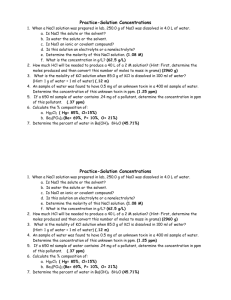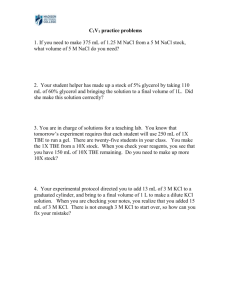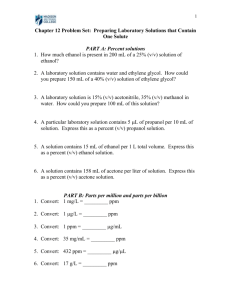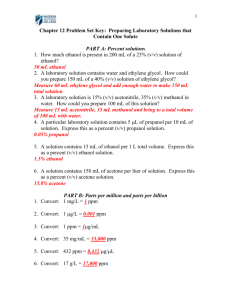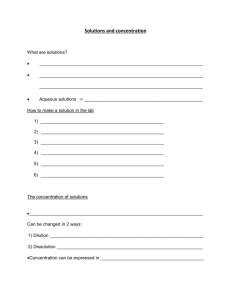Homework-Solution Concentrations
advertisement
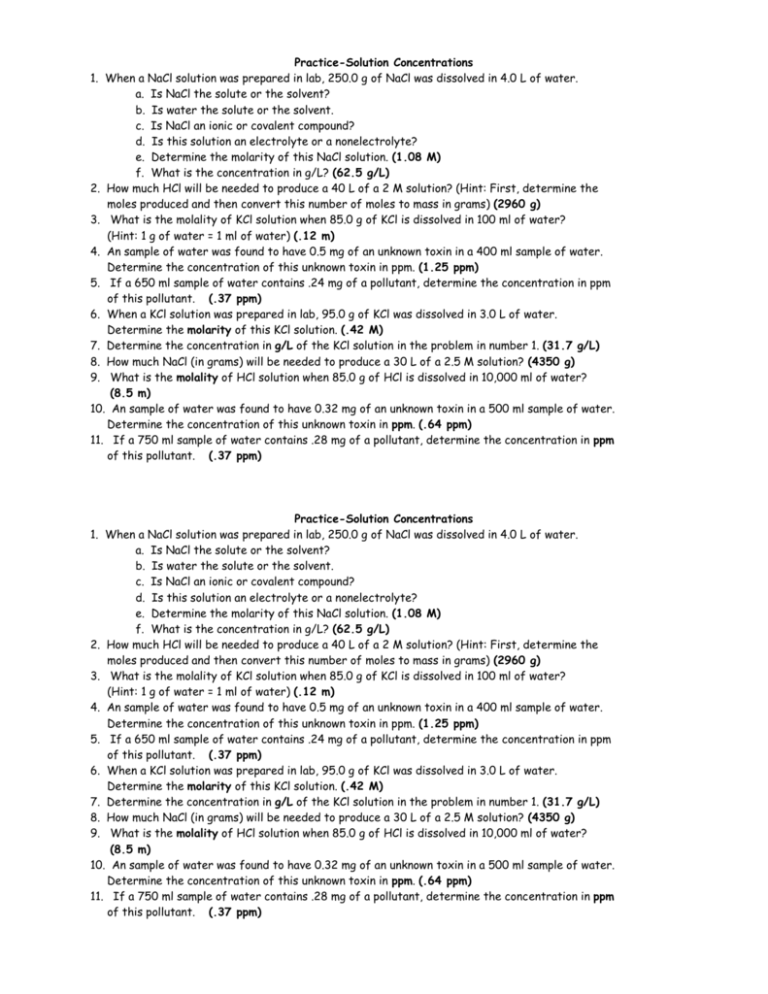
Practice-Solution Concentrations 1. When a NaCl solution was prepared in lab, 250.0 g of NaCl was dissolved in 4.0 L of water. a. Is NaCl the solute or the solvent? b. Is water the solute or the solvent. c. Is NaCl an ionic or covalent compound? d. Is this solution an electrolyte or a nonelectrolyte? e. Determine the molarity of this NaCl solution. (1.08 M) f. What is the concentration in g/L? (62.5 g/L) 2. How much HCl will be needed to produce a 40 L of a 2 M solution? (Hint: First, determine the moles produced and then convert this number of moles to mass in grams) (2960 g) 3. What is the molality of KCl solution when 85.0 g of KCl is dissolved in 100 ml of water? (Hint: 1 g of water = 1 ml of water) (.12 m) 4. An sample of water was found to have 0.5 mg of an unknown toxin in a 400 ml sample of water. Determine the concentration of this unknown toxin in ppm. (1.25 ppm) 5. If a 650 ml sample of water contains .24 mg of a pollutant, determine the concentration in ppm of this pollutant. (.37 ppm) 6. When a KCl solution was prepared in lab, 95.0 g of KCl was dissolved in 3.0 L of water. Determine the molarity of this KCl solution. (.42 M) 7. Determine the concentration in g/L of the KCl solution in the problem in number 1. (31.7 g/L) 8. How much NaCl (in grams) will be needed to produce a 30 L of a 2.5 M solution? (4350 g) 9. What is the molality of HCl solution when 85.0 g of HCl is dissolved in 10,000 ml of water? (8.5 m) 10. An sample of water was found to have 0.32 mg of an unknown toxin in a 500 ml sample of water. Determine the concentration of this unknown toxin in ppm. (.64 ppm) 11. If a 750 ml sample of water contains .28 mg of a pollutant, determine the concentration in ppm of this pollutant. (.37 ppm) Practice-Solution Concentrations 1. When a NaCl solution was prepared in lab, 250.0 g of NaCl was dissolved in 4.0 L of water. a. Is NaCl the solute or the solvent? b. Is water the solute or the solvent. c. Is NaCl an ionic or covalent compound? d. Is this solution an electrolyte or a nonelectrolyte? e. Determine the molarity of this NaCl solution. (1.08 M) f. What is the concentration in g/L? (62.5 g/L) 2. How much HCl will be needed to produce a 40 L of a 2 M solution? (Hint: First, determine the moles produced and then convert this number of moles to mass in grams) (2960 g) 3. What is the molality of KCl solution when 85.0 g of KCl is dissolved in 100 ml of water? (Hint: 1 g of water = 1 ml of water) (.12 m) 4. An sample of water was found to have 0.5 mg of an unknown toxin in a 400 ml sample of water. Determine the concentration of this unknown toxin in ppm. (1.25 ppm) 5. If a 650 ml sample of water contains .24 mg of a pollutant, determine the concentration in ppm of this pollutant. (.37 ppm) 6. When a KCl solution was prepared in lab, 95.0 g of KCl was dissolved in 3.0 L of water. Determine the molarity of this KCl solution. (.42 M) 7. Determine the concentration in g/L of the KCl solution in the problem in number 1. (31.7 g/L) 8. How much NaCl (in grams) will be needed to produce a 30 L of a 2.5 M solution? (4350 g) 9. What is the molality of HCl solution when 85.0 g of HCl is dissolved in 10,000 ml of water? (8.5 m) 10. An sample of water was found to have 0.32 mg of an unknown toxin in a 500 ml sample of water. Determine the concentration of this unknown toxin in ppm. (.64 ppm) 11. If a 750 ml sample of water contains .28 mg of a pollutant, determine the concentration in ppm of this pollutant. (.37 ppm)
